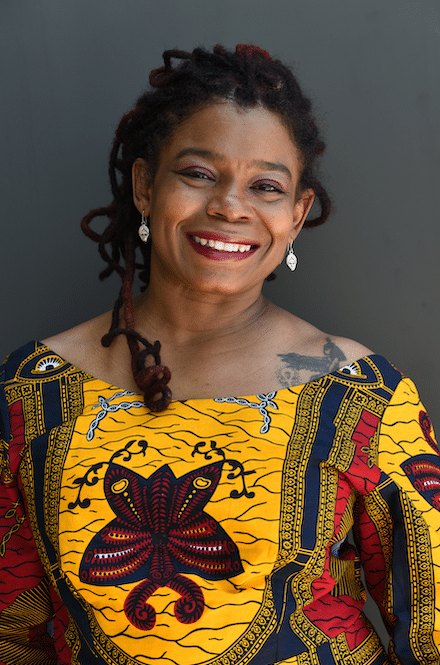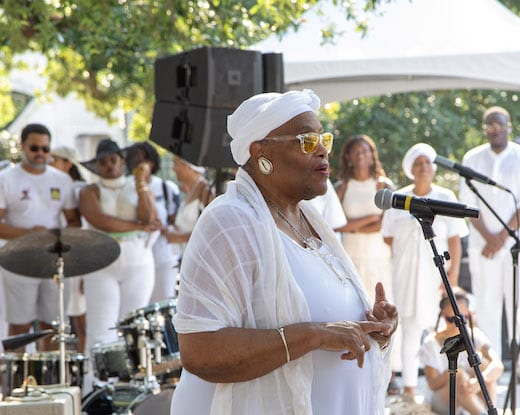Free to Imagine: Ashé Cultural Arts Center
In honor of the twenty-year anniversary of Hurricane Katrina, we’re remembering the culture and lives lost in the devastation and recognizing the culture and community that continues to shine in New Orleans and across the Gulf Coast. We recently sat down with our Thriving Cultures partner Ashé Cultural Arts Center to discuss how the organization is harnessing the power of art and culture to support human, community, and economic development in New Orleans. Read the full story and more in our recent six-year impact report: Journey to Justice.
______
Free to Imagine
In New Orleans, culture is the air people breathe. But even here, where secondlines thread through neighborhoods, jazz flows from street corners, and food and arts abound, the people who carry that culture often get the short end of the stick. The Ashé Cultural Arts Center, tucked into a century-old building on Oretha Castle Haley Boulevard, was built to change that.
Founded in 1998 by writer and producer Carol Bebelle and visual artist Douglas Redd, Ashé was born as a counternarrative to the negative stereotypes of Black Americans in arts and media at the time. It was envisioned as a place where Black artists and residents could gather, create, and imagine their future on their own terms.

“The vision,” says Asali DeVan Ecclesiastes, Ashé’s chief equity and executive officer, “was to help Black people fall in love with ourselves, and to give ourselves grace for what we have experienced and continue to experience in society and to extend that grace to others.”
Asali joined Ashé as a young poet, witnessing its evolution from community dream to institutional anchor. Now, she leads the organization with reverence and ambition. “We’re reaching toward equity with real estate portfolios, community investment funds, and building a hotel,” she says, noting how Ashé has clarified its mission over the years to use art and culture to support human, community, and economic development. “We are very honored that we are able to serve in that way for our community in every phase of life,” Asali says.

“The vision was to help Black people fall in love with ourselves, and to give ourselves grace for what we have experienced and continue to experience in society and to extend that grace to others.”
–Asali DeVan Ecclesiastes, Ashé’s chief equity and executive officer
Ashé is part art and performance venue, part wellness hub, part civic space. It hosts baby showers and community meetings. It offers affordable housing. It holds workshops for all ages and countless ways to rest, imagine, and experience art. It also pays artists—not just for shows, but to serve as community health workers through its “I Deserve It!” program, where trusted local creatives promote mental and physical wellness.
In New Orleans, redlining, neglect, and natural disasters have taken a heavy toll on the health and wealth of low-income people, including artists of color. The average cultural worker in the city earns just $35,000—and Indigenous culture bearers as little as $17,000. Ashé offers its community not just opportunity, but infrastructure to flourish.
“The support we’ve gotten from the Surdna Foundation,” Asali explains, referencing its grants that began after Hurricane Katrina, “lets us build capacity. It let us offer a retirement to our founding executive director. Most nonprofits can’t do that—especially not Black-led ones.”
In the storm’s aftermath, Surdna saw Ashé not just as a grantee, but a lifeline. Since 2005, Surdna has provided over $2.4 million in general operating support, allowing Ashé to think long-term.
“Ashé Cultural Arts Center is an exemplar,” says Robert Smith III, senior program officer for Thriving Cultures at Surdna. “It preserves history and heritage and nurtures creativity and radical imagination. But it offers much more than that. Ashé offers community, dignity, strategy, economic opportunity, housing, and hope.”
“We have a connection to history and real life. We authentically know who our people are. That’s profoundly different from other places.”
–LaShaunda Pickett-René, Chief Strategy Officer

Ashé is now leading a partnership with the New Orleans Data Center to track the impact of small cultural institutions led by people of color on their communities and models of financial stability. It’s part of a broader effort to prove what New Orleans already knows: arts and cultural institutions are essential.
Ashé also convenes the Alliance for Cultural Equity, a cohort of local archives and institutions preserving the histories of marginalized communities in New Orleans. This is not simply about legacy—it’s about ownership, memory, and economic equity.
Reflecting on her favorite aspects of New Orleans culture, Asali says, “We take care of each other.” Ashé Chief Finance Officer Joann Minor adds, “We dance in the streets. We show joy.” And with pride in her voice, Chief Strategy Officer LaShaunda Pickett-René says, “We have a connection to history and real life. We authentically know who our people are. That’s profoundly different from other places.”
At a time when Black institutions across the country are underfunded, under threat, or simply overlooked, Ashé remains a powerful example of what’s possible when culture is not just celebrated but centered. It’s a model for what arts, culture, and community can look like—rooted in the past but built for the future.
Ashé. So let it be. And make it happen.

